Dad and I slept late and were awakened by soft music from the in-cabin loudspeaker, plus the announcement that breakfast would be served in half an hour. As we moseyed to breakfast, we discovered we were not the only people taking it easy today:
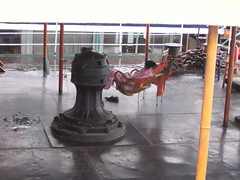
This fella is on the neighboring boat.
Next, we attended a ship talk from Freddy, the river guide. Freddy (as opposed to Fred) is supplied by China Regal, and knows this section of the Yangtze backwards and forwards. He showed us a cool topographical map
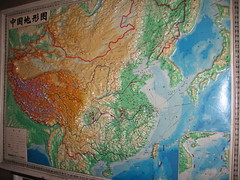
and talked about the geography of China, from the Tibetan plateau down through the Yangtze river basin. Of course we talked about last month's Chengdu earthquake; Freddy pointed out the line of stress from where India runs into Asia, throwing up the Himalayas, through Chengdu, and straight up to Tangshan in the northeast, where there was a major earthquake in the 1970s. Apparently that whole line is an earthquake zone. Interesting!
I returned to the cabin for a wee lie-down, then knitted for an hour or so before moseying (my top speed today) to lunch. Dad decided he was done for the day at this point, and put his feet up. I girded my loins and went on the shore excursion they arranged for us, to see the sights of Greater Yichang.
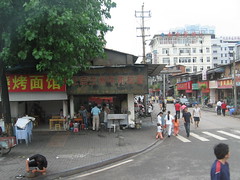
I had a really good time. Our guide, "Alan", took us first to the Museum of Yichang, a grandiose name for the place, which seemed to have been opened especially for us; there certainly were no other patrons there. They hustled us through really quickly, but I remember that it focused on the early history of the indigenous people. I liked the display of spindle whorls. At the end was a gift shop with a twist: you could buy real antiques, legitimately, for the benefit of the museum. Legally-salable antiquities had to be 400 years old or less, and we were told they were duplicates: somebody finds a dozen identical Ming-era bottles and the museum keeps one and sells off the other 11.
Our other destination is up in the hills a bit. On the way there, while we were crossing a bridge, we saw this little platform, built way out over the river:
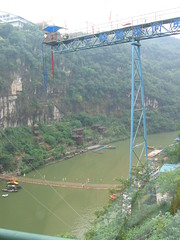
I guess the Chinese have extreme sports too; the platform is apparently used by Bungee jumpers!
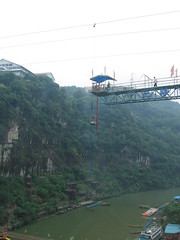
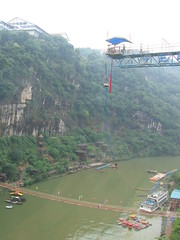
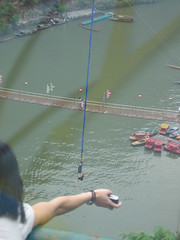
We soon reached the Three Visitors Cave, our last stop.
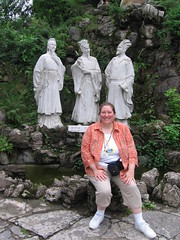
In order to get to the cave itself, we had a bit of a hike: there are paths to several points of interest all over this cliffside. This area - I don't know if I should call it a park - was recently restored, so there are no loose stones in the paths (thank goodness!) They are made of rock from local quarries, some of which contains gorgeous fossils:
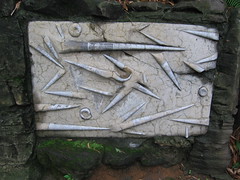
This slab is mounted in a wall as a decoration, but these fossils were all through the paving stones. The pointy ones are the straight version of a chambered nautilus.
We ambled up and down the paths
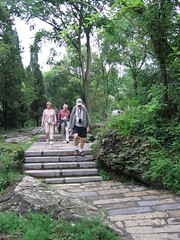
or maybe clambered is the word,
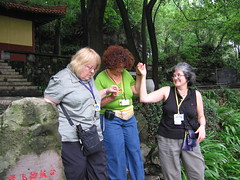
often coming upon breathtaking views of the gorge
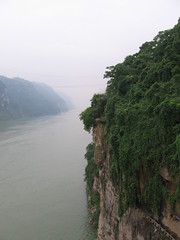
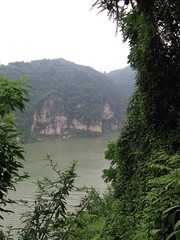
and points of interest like the Drum Beating Platform
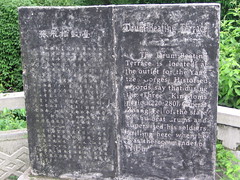
from which a statue of a very rugged drummer glowers across the Xiling Gorge:

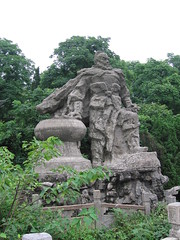
We also saw a building embedded in the trees at the edge of the gorge:
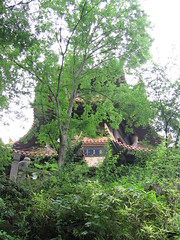
I think this is the one called the "Shusai Building". It has a carillon, though nobody was playing it today, and a spiral staircase

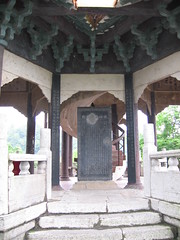
which only the intrepid Ashley was willing to climb. (She's the teenager who came with her grandmother. Young and strong.)
Although our path had a fair amount of "Up", the general trend was "Down", which gradually transformed into "DOWN":
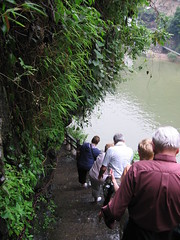
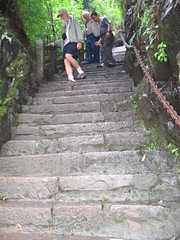
We passed under an overhang carved in the living rock face
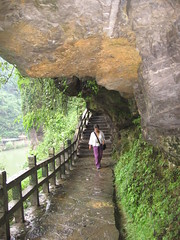
then through a slightly oppressive tunnel
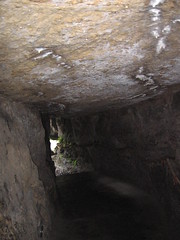
and debouched in front of the Three Visitors Cave proper:
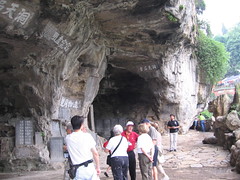
This charmingly-named cave was the site of a ninth-century poetry slam: it was a custom of the Chinese literati to take a picnic to some beautifully scenic place when they had some free time. They would eat al fresco, drink jars of wine, and write extemporaneous poetry, and if possible they would inscribe their verses on the walls of the pavilion, or in this case, carve them into the walls of the cave, where the event took place.
In the case of the Three Visitors Cave, two separate trios of literary gentlemen partied there 137 years apart, both carving their poems into the cave walls. It became a tradition to do this, and over the years the walls have acquired a lot of graffiti:

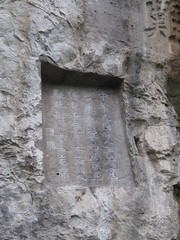
In the inner room of the cave you can see statues of the original Three Visitors (or Three Travelers; it varies):
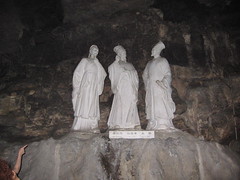
I had a nice time poking around the cave and admiring the calligraphy. (Mama always punished me when I wrote on the walls. I'm just saying.)
Our return to the bus was surprisingly easy; we only faced a little "Up". It turned out - big surprise - there was a souvenir shop on the edge of the parking lot. There I made a triumphant discovery: they were selling those long pointy fossils! My buddy Robert is into fossils and I got him a nice one. Still no goldfish though.

No comments:
Post a Comment